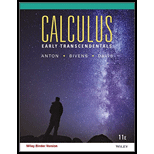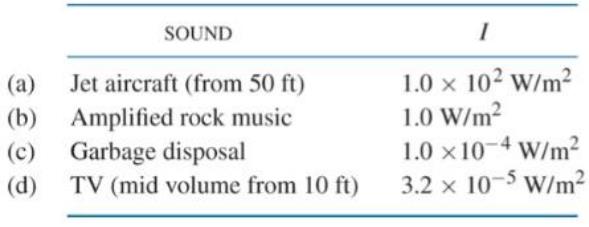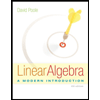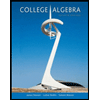1 Limits And Continuity 2 The Derivative 3 Topics In Differentiation 4 The Derivative In Graphing And Applications 5 Integration 6 Applications Of The Definite Integral In Geometry, Science, And Engineering 7 Principles Of Integral Evaluation 8 Mathematical Modeling With Differential Equations 9 Infinite Series 10 Parametric And Polar Curves; Conic Sections 11 Three-dimensional Space; Vectors 12 Vector-valued Functions 13 Partial Derivatives 14 Multiple Integrals 15 Topics In Vector Calculus expand_more
1.1 Limits (an Intuitive Approach) 1.2 Computing Limits 1.3 Limits At Infinity; End Behavior Of A Function 1.4 Limits (discussed More Rigorously) 1.5 Continuity 1.6 Continuity Of Trigonometric Functions 1.7 Inverse Trigonometric Functions 1.8 Exponential And Logarithmic Functions Chapter Questions expand_more
Problem 1QCE: The function y=12x has domain and range . Problem 2QCE: The function has domain and range .
Problem 3QCE: Express as a power of 4 : (a) 1 (b) 2 (c) 116 (d) 8 (e) 5 . Problem 4QCE: Solve each equation for x . (a) ex=12 (b) 103x=1,000,000 (c) 7e3x=56 Problem 5QCE: Solve each equation for x . (a) lnx=3 (b) logx1=2 (c) 2logxlogx+1=log4log3 Problem 1ES: Simplify the expression without using a calculating utility. (a) 82/3 (b) 82/3 (c) 82/3 Problem 2ES: Simplify the expression without using a calculating utility. (a) 24 (b) 41.5 (c) 90.5 Problem 3ES: Use a calculating utility to approximate the expression. Round your answer to four decimal places.... Problem 4ES: Use a calculating utility to approximate the expression. Round your answer to four decimal places.... Problem 5ES: Find the exact value of the expression without using a calculating utility. (a) log216 (b) log2132... Problem 6ES: Find the exact value of the expression without using a calculating utility. (a) log100.001 (b)... Problem 7ES: Use a calculating utility to approximate the expression. Round your answer to four decimal places.... Problem 8ES: Use a calculating utility to approximate the expression. Round your answer to four decimal places.... Problem 9ES: Use the logarithm properties in Theorem 1.8.3 to rewrite the expression in terms of r,s, and t,... Problem 10ES: Use the logarithm properties in Theorem 1.8.3 to rewrite the expression in terms of r,s, and t,... Problem 11ES: Expand the logarithm in terms of sums, differences, and multiples of simpler logarithms. (a)... Problem 12ES: Expand the logarithm in terms of sums, differences, and multiples of simpler logarithms. (a)... Problem 13ES: Rewrite the expression as a single logarithm. 4log2log3+log16 Problem 14ES: Rewrite the expression as a single logarithm. 12logx3logsin2x+2 Problem 15ES: Rewrite the expression as a single logarithm. 2lnx+1+13lnxlncosx Problem 16ES: Solve for x without using a calculating utility. log101+x=3 Problem 17ES: Solve for x without using a calculating utility. log10x=1 Problem 18ES: Solve for x without using a calculating utility. lnx2=4 Problem 19ES: Solve for x without using a calculating utility. ln1/x=2 Problem 20ES: Solve for x without using a calculating utility. log33x=7 Problem 21ES: Solve for x without using a calculating utility. log552x=8 Problem 22ES: Solve for x without using a calculating utility. ln4x3lnx2ln2 Problem 23ES: Solve for x without using a calculating utility. ln1/x+ln2x3=ln3 Problem 24ES: Solve for x without using a calculating utility. Use the natural logarithm anywhere that logarithms... Problem 25ES: Solve for x without using a calculating utility. Use the natural logarithm anywhere that logarithms... Problem 26ES: Solve for x without using a calculating utility. Use the natural logarithm anywhere that logarithms... Problem 27ES: Solve for x without using a calculating utility. Use the natural logarithm anywhere that logarithms... Problem 28ES: Solve for x without using a calculating utility. Use the natural logarithm anywhere that logarithms... Problem 29ES: Solve for x without using a calculating utility. Use the natural logarithm anywhere that logarithms... Problem 30ES: Solve e2x3ex=2 for x without using a calculating utility. Problem 31ES: In each part, identify the domain and range of the function, and then sketch the graph of the... Problem 32ES: In each part, identify the domain and range of the function, and then sketch the graph of the... Problem 33ES: In each part, identify the domain and range of the function, and then sketch the graph of the... Problem 34ES: In each part, identify the domain and range of the function, and then sketch the graph of the... Problem 35ES: Determine whether the statement is true or false. Explain your answer. The function y=x3 is an... Problem 36ES: Determine whether the statement is true or false. Explain your answer. The graph of the exponential... Problem 37ES: Determine whether the statement is true or false. Explain your answer. The natural logarithm... Problem 38ES: Determine whether the statement is true or false. Explain your answer. The domain of a logarithmic... Problem 39ES: Use a calculating utility and the change of base formula 9 to find the values of log27.35 and... Problem 40ES: Graph the functions on the same screen of a graphing utility. [Use the change of base formula 9 ,... Problem 41ES: Graph the functions on the same screen of a graphing utility. [Use the change of base formula 9 ,... Problem 42ES: (a) Derive the general change of base formula logbx=logaxlogab (b) Use the result in part (a) to... Problem 43ES: Use a graphing utility to estimate the two points of intersection of the graphs of y=1.3x and... Problem 44ES: Use a graphing utility to estimate the two points of intersection of the graphs of y=0.6x2 and... Problem 45ES: (a) Is the curve in the accompanying figure the graph of an exponential function? Explain your... Problem 46ES: (a) Make a conjecture about the general shape of the graph of y=loglogx, and sketch the graph of... Problem 47ES: Find the fallacy in the following “proof� that 1814 . Multiply both sides of the inequality 32... Problem 48ES: Prove the four algebraic properties of logarithms in Theorem 1.8.3 . Problem 49ES Problem 50ES: Find the limits. limx+1ex1+ex Problem 51ES: Find the limits. limx+ex+exexex Problem 52ES Problem 53ES: Find the limits. limx+ln2x2 Problem 54ES: Find the limits. limx0+ln2x2 Problem 55ES: Find the limits. limx+x+1xxx Problem 56ES: Find the limits. limx+1+1xx Problem 57ES: Evaluate the limit using an appropriate substitution. (See Exercises 45-46 of Section 1.3.)... Problem 58ES: Evaluate the limit using an appropriate substitution. (See Exercises 45-46 of Section 1.3.)... Problem 59ES: Evaluate the limit using an appropriate substitution. (See Exercises 45-46 of Section 1.3.)... Problem 60ES: Evaluate the limit using an appropriate substitution. (See Exercises 45-46 of Section 1.3.)... Problem 61ES: Evaluate the limit using an appropriate substitution. (See Exercises 45-46 of Section 1.3.)... Problem 62ES: Evaluate the limit using an appropriate substitution. (See Exercises 45-46 of Section 1.3.)... Problem 63ES: Evaluate the limit using an appropriate substitution. (See Exercises 45-46 of Section 1.3.)... Problem 64ES: Evaluate the limit using an appropriate substitution. (See Exercises 45-46 of Section 1.3.)... Problem 65ES: Let fx=bx, where 0b . Use the substitution principle to verify the asymptotic behavior of f that is... Problem 66ES: Prove that limx01+x1/x=e by completing parts (a) and (b). (a) Use Equation 4 and the substitution... Problem 67ES: Suppose that the speed (in ft/s) of a skydiver t second after leaping form a plane is given by the... Problem 68ES: The population p of the United States (in millions) in year t can be modelled by the function... Problem 69ES: (a) Compute the (approximate) values of the terms in the sequence... Problem 70ES: Let fx=1+1xx . (a) Prove the identity fx=xx1fx1 (b) Use Equation (d) and the identity form part (a)... Problem 71ES: If equipment in the satellite of Example 3 requires 15 watts to operate correctly, what is the... Problem 72ES: The equation Q=12e0.055t gives the mass Q in grams of radioactive potassium-42 that will remain from... Problem 73ES: The acidity of a substance is measured by its pH value, which is defined by the formula pH=logH+... Problem 74ES: Use the definition of pH in Exercise 73 to find H+ in a solution having a pH equal to (a) 2.44 (b)... Problem 75ES: The perceived loudness of a sound in decibels dB is related to its intensity I in watts per square... Problem 76ES: Use the definition of the decibel level of a sound (see Exercise 75). If one sound is three times as... Problem 77ES: Use the definition of the decibel level of a sound (see Exercise 75). According to one source, the... Problem 78ES: Use the definition of the decibel level of a sound (see Exercise 75). Suppose that the intensity... Problem 79ES: On the Richter scale, the magnitude M of an earthquake is related to the released energy E in joules... Problem 80ES: Suppose that the magnitudes of two earthquakes differ by 1 on the Richter scale. Find the ratio of... format_list_bulleted



 Algebra & Trigonometry with Analytic GeometryAlgebraISBN:9781133382119Author:SwokowskiPublisher:Cengage
Algebra & Trigonometry with Analytic GeometryAlgebraISBN:9781133382119Author:SwokowskiPublisher:Cengage Linear Algebra: A Modern IntroductionAlgebraISBN:9781285463247Author:David PoolePublisher:Cengage Learning
Linear Algebra: A Modern IntroductionAlgebraISBN:9781285463247Author:David PoolePublisher:Cengage Learning College AlgebraAlgebraISBN:9781305115545Author:James Stewart, Lothar Redlin, Saleem WatsonPublisher:Cengage Learning
College AlgebraAlgebraISBN:9781305115545Author:James Stewart, Lothar Redlin, Saleem WatsonPublisher:Cengage Learning


